Sunday July 16: The Press Conference at Huddard School
The Press Conference at Huddard School. We sit down in a semi-circle in front of small tables. 1 PM and there’s almost no one here, except for our hostess Mrs Bajpai, the Environmental Studies Coordinator at Huddard. Two gentlemen of the Press slouch in and seat themselves in the front row. We wait. Three high school principals come and sit down next to us. But no sign of either of the principals of the two host schools - Delhi Public School - Kalyanpur or St Mary’s Convent school in Cantonment. 1.15 PM. time to start the proceedings.
The senior journalist from The Pioneer hauls Rakesh over the coals ‘why always the same high school principals? Isn’t this evidence that the decade-long Eco-Friends campaign to raise public awareness about Ganga has hit a plateau, has stalled? He has a valid point. Rakesh gamely defends the absent principals: ‘They must have other engagements. They are staunch supporters of our activities,’ which is true. But the tone of the so-called press conference has been established right from the outset. This will be a real conversation, no holds barred.
The discussion has substance, not the usual pieties. Why has the Ganga Action Plan failed? Why is the public still indifferent? We all agree awareness has been created. In this at least Rakesh has succeeded. But creating awareness is not enough unless it is followed by real changes. The various institutions simply do not feel any pressure from public anger. The press can only do so much. David Black, the environmental science teacher from Groton, explains that even in the United States public awareness has started to flag. The high spot was the early 1970s. Now everything is subject to cost-benefit analysis. Concern for the environment is still there, but it is under threat. The only hope lies with the youth. They do have concern for environmental values. Hopefully, it will surface a generation from now, when they are in positions to do something about it.
There is much good and spirited discussion. Ten more members of the press have trooped in. Photos flash - they all want to take Vicky, Kathy and Emily - and why not? Julian is doing his usual number - things have to hit rock bottom and people be really affected in their personal lives - before they will get better. Until then, most people will continue to pay lip service to saving Ganga, but use her as a free, infinite resource. But will the river’s condition have gone beyond the tipping point before they wake up to what they have done?
We come away feeling the issues have been well-aired and engaged.
Monday July 17: 9.00 AM St Mary’s Convent School
 9.00 AM St Mary’s Convent School. The school is physically impressive - tidy, airy, the students not afraid to engage in real conversations. Sr Deepa, the Principal is firmly impressive, Miss Trivedi, the teacher in charge of the Chemistry Laboratory, scarcely less so. David explains the day’s programme. We will take samples at three sites - Massacre Ghat (for city sewage), Dapka Nullah for raw tannery effluent, and the irrigation canal beyond Jajmau to see what exactly is in the famous irrigation water that the Sewage Treatment plant so ‘generously’ sends to the villages around to irrigate their fields.
9.00 AM St Mary’s Convent School. The school is physically impressive - tidy, airy, the students not afraid to engage in real conversations. Sr Deepa, the Principal is firmly impressive, Miss Trivedi, the teacher in charge of the Chemistry Laboratory, scarcely less so. David explains the day’s programme. We will take samples at three sites - Massacre Ghat (for city sewage), Dapka Nullah for raw tannery effluent, and the irrigation canal beyond Jajmau to see what exactly is in the famous irrigation water that the Sewage Treatment plant so ‘generously’ sends to the villages around to irrigate their fields.
DPS-Kalyanpur are determined not to miss a thing, so they’ve sent their team of six students and a newly-energised Anand Pandey to take part in the day’s sampling. They arrive on time in a huge DPS bus and we set out for Massacre ghat. Large boisterous crowds bathing - it appears to be some festival or other. Not suitable to take samples because all those bodies will churn up the water. Bhagwan, the Eco-Friends' boatman who had rowed us up to Sarsaiyya ghat in November 2004, takes two plastic bottles, dives in upstream of the ghat, and returns with samples. The DPS team now show their mettle. They’ve brought proper sampling jars, already labelled, complete with plastic stoppers. They take their samples quietly and without fuss. They’re impressive and know what they’re doing and why.
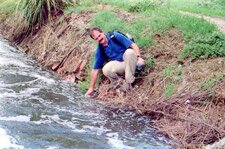 On to Dapka Nullah, where we take samples in the river just below the actual nullah. Since our last visit in November 2004, the Main Trunk Sewer has been repaired. The monsoon, which began a week ago, has diluted the black sludge flowing in from the nullah. A year ago, it obstinately refused to mix with Ganga for several hundred yards - a black and brown Ganga flowed side by side.
On to Dapka Nullah, where we take samples in the river just below the actual nullah. Since our last visit in November 2004, the Main Trunk Sewer has been repaired. The monsoon, which began a week ago, has diluted the black sludge flowing in from the nullah. A year ago, it obstinately refused to mix with Ganga for several hundred yards - a black and brown Ganga flowed side by side.
Finally, past the Sewage Treatment plant complex to the irrigation canal. The concrete canal splits at a little bridge. Both teams scramble down the bank to take their samples - David takes an additional sample from the tube well where the villagers get their drinking water. I wonder what the tests in the labs at St. Mary’s and DPS will make of that?
Then back into the bus and to St. Mary’s where a TV crew have arrived to film interviews with Rakesh, David, Katie and Dipti Dhawan from St. Mary’s Convent. The students seem unfazed by the cameras and continue talking articulately with David about their previous sampling/testing. David is highly impressed by all the students. They are ready to explode with their enthusiasm and energy. Only now do the St Mary’s team reveal this is their first time ever on the river. Previously, all their work has been strictly within the confines of the school!
Tuesday July 18
9.00 AM we sidle into St Mary’s and straight up to the second floor Chemistry Lab - the five of us and six SMC girls plus Miss Trivedi. The lab seems old-fashioned but clean and neat. David explains we’re going to try and test for the presence of five elements and compounds - chromate, nitrate, phosphate, iron, and copper. But first, we have to filter the samples gathered yesterday, They contain far too much clay, something David had not anticipated. Maybe we could have warned him, but then no one had ever told us that sediments could mean clay.
Incidentally, the presence of so much clay does tend to confirm Graham Chapman’s thesis that most silts only travel a few kilometers every year, that sediments in the Plains have little or no connection with deforestation in the Himalaya. So much clay strongly suggests this sediment is very local.
Unfortunately, the first batch of filter paper is too coarse, too much clay is still getting through. So the samples are filtered a second time, through finer filter paper. We test for chrome and the results are a little surprising. Yes, there are high levels of chrome where you’d expect them - at Dapka Nullah especially - but they aren’t off the charts. The surprise is not especially elevated levels in the irrigation canal from the Sewage Treatment plant.
David suddenly slaps his head: he’s testing for suspended chromium in the water, but maybe much of the chromium has already sunk to the bed of the river, trapped by the clay? In that case a far more sophisticated and expensive test would be required, one his simple Colorimeters cannot perform. Worse, the initial filtering may have removed much chromate. So the actual numbers may mean nothing. What is important is that there is appreciable chromium at Massacre Ghat, upstream of the tanneries, and absolutely none in the water from the tube well downstream of the Sewage Treatment Plant. So, yes, chromium is coming directly from the tanneries. But which tanneries and how much we cannot say.
The other tests makes it more interesting. We find surprising levels of iron at Massacre ghat. How come? Is some industry discharging its wastes? But which industry in Kanpur uses iron? The sewage pipes? But the water at Massacre Ghat is near an untapped nullah. High concentrations of copper are found in the irrigation canal, but nowhere else? Again how come? The tube well shows a massive nitrate presence. This doesn’t make sense. Finally, high phosphates at Massacre ghat, Dapkah Nullah and in the irrigation canal. There are possible explanations - nearby dhobis or massive runoff from the fields near the irrigation canal.
The ten girls have been working with energy and enthusiasm for three hours. But time is up. They want to come to Delhi Public School tomorrow. They don’t want to be left out. This is too much fun!. Sr Deepa consents - the bus will bring them.
David is left gingerly wondering how he can avoid becoming a pawn in a public debate. Yes, the tanneries are polluting, but so are a lot of other people. Where does the iron come from? Why such extraordinary levels of nitrate in the tube well? Maybe piling all the blame on the tanneries is too simplistic and tempting? Maybe the blame game should be spread a bit more widely? Tomorrow’s sample in Bithur may help explain some of these anomalies by giving us a benchmark upstream of Kanpur.
Wednesday July 19
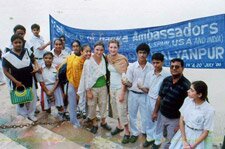 What the hell was he thinking of?
What the hell was he thinking of?
We duly arrive at Delhi Public School at the appointed hour, do the formalities then troop out. We adults to go to Bithur in the Eco-Friends Sumo, the dozen St Mary’s and Delhi Public School students presumably in a small bus.
And then strange things start happening. Bus No 3 is a large bus. The Kanpur students, our three girls install themselves. Then twenty-odd young men and women, obviously European, clamber in after them.
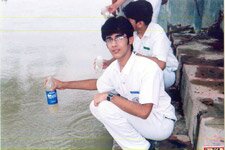 ‘Rakesh, where the hell did they come from?’
‘Rakesh, where the hell did they come from?’
“They are students going down Ganga in a bus. Can they come with you? Can they be part of the group sampling water? Can David Black teach them too?’
Martine is more diplomatic than I. Our group are here to do two very specific things: water sampling and forming relationships between the schools. Suddenly having a second group of young adults introduced with no explanation will disrupt both things. David has been teaching these two groups for two days. This new group - we don’t know who they are? What they want?’
‘They are here on a two week study group. I told them they could join.’
‘Well please go and untell them. It’s discourteous to us and our two groups.’
 We trundle down through the fields of the Kalyanpur road to Bithur - we park at Brahmavarta ghat, the bus a few hundred yards away in a side lane where it can turn and exit when the time comes.
We trundle down through the fields of the Kalyanpur road to Bithur - we park at Brahmavarta ghat, the bus a few hundred yards away in a side lane where it can turn and exit when the time comes.
David is concerned that the bathers at the main ghat will stir up sediments and make readings unreliable. So he opts to take samples fifty yards either side. On the ride back he stops to take a sample from a tube well at the octroi gate. He wants to be reassured that the drinking water readings in nitrate he found near Jajmau were the exception, not the rule.
The student group tell Martine many of them are just along for the ride. They have no background in either India or environmental science, but came on this study trip to fulfill university requirements. They are supposed to gather samples and send them somewhere in Varanasi to be tested.
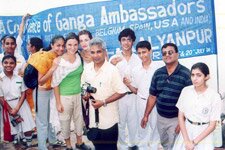 ‘What are you testing for?’ ‘I don’t know.’
‘What are you testing for?’ ‘I don’t know.’
‘What are you studying?’
‘Accounting.’
Yes, precisely!
Before we call it a day David goes and takes samples from the tube well outside the Attic and at Baba ghat, next to the Green Park cricket ground. They should help in determining how much pollution upstream of the tanneries is going into the river.
Thursday July 20
A good day! No college students. They were off doing a street play about Ganga. But it didn’t start out that well. Another inaccurate article about us from The Times of India. Why can’t they get quotes right? This one had me saying the exact opposite of what I did say. In the past David Black has been the victim for such sloppy practices.
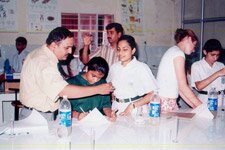 The DPS lab was splendid and the ten students worked straight through for three hours, and worked together. All three adults really enjoyed Sudhir Tewari, the lab teacher. He ‘got’ what we were trying to do, and why and interacted easily with his own students. A man to nurture.
The DPS lab was splendid and the ten students worked straight through for three hours, and worked together. All three adults really enjoyed Sudhir Tewari, the lab teacher. He ‘got’ what we were trying to do, and why and interacted easily with his own students. A man to nurture.
Because David had previously worked out some of the testing teething problems at SMC there was time to do all five parameters. Mostly no surprises except for the persistent presence of iron everywhere, and a very disturbing and inexplicable presence of large amounts of nitrate in both tube wells!
Later David met Vinod Tare at IIT-Kanpur, who admitted that while iron seemed naturally to occur in groundwater, even he was at a loss about the presence of nitrates in the tube wells. However, he cautioned David that Rakesh’s figures for the presence of chromium in Ganga were simply not credible. He had tested in Jajmau for the Central Pollution Control Board and never found figures as high. But any chromium at all was too much. He added that the Sewage Treatment Plant was once again not working.
Friday July 21
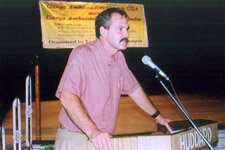 I feared this might be anticlimactic, but it went off splendidly. Eleven schools sent delegations, more than we had dared expect, and Mrs Bajpai, the Environmental Science teacher at Huddard, told Martine she regretted Huddard had not signed up to take part. Later, Mr Vincent, the Principal at Huddard, even went so far as to say the school should buy two Colorimeters so they could test groundwater in the area.
I feared this might be anticlimactic, but it went off splendidly. Eleven schools sent delegations, more than we had dared expect, and Mrs Bajpai, the Environmental Science teacher at Huddard, told Martine she regretted Huddard had not signed up to take part. Later, Mr Vincent, the Principal at Huddard, even went so far as to say the school should buy two Colorimeters so they could test groundwater in the area.
David was master of ceremonies. He gave a brief outline of what we had been doing the past four days and then had everyone divide up into groups to come up with answers to two questions - what is pollution? And draft legislation to control pollution. The first question produced a lot of very textbook answers - all featuring the word ‘undesirable.’ The answers were standard, only one suggested that a polluted environment affects human beings. The second question floored them all. David asked them to outline legislation to control pollution. They hadn’t a clue. They all gave speeches about ‘sacred Ganga.’ Nothing at all about legislation. David had suggested they would need to balance controls on pollution with the need to preserve industries and therefore people’s livelihoods. Even so, they all answered a totally question. Dipti Dhawan’s answer was the most flagrant: she gave an updated version of her 2005 prize-winning speech about Ganga’s pollution. I caught her on it. She was not happy!
In the final session David gave an extremely balanced presentation of the findings and cautioned that absolute numbers had little meaning. He suggested low-tech solutions, such as artificial wetlands, and the use of various plant species to eliminate bacteria and fix heavy metals. His solutions were low on energy use (just a simple pump to move the water on) and could be performed in an area of two hectares (4 acres).
| Average of level |
Parameter |
| Sample Site |
Copper |
Hex Chrome |
Iron |
Nitrate |
Phosphate |
| Dabka Ghat |
0
|
0.075
|
2.745
|
1.53
|
1.155
|
|
Irrigation Canal
|
0.04
|
0.015
|
1.635
|
0.42
|
1.35
|
|
Massacre Ghat
|
0
|
0.03
|
2.465
|
1.38
|
1.45
|
|
Tube Well
|
0
|
0.02
|
0.1
|
OR
|
0.58
|
| Average of level |
Parameter |
| Sample Site |
Copper* |
Hex Chrome |
Iron |
Nitrate |
Phosphate |
| Baba Ghat |
1.195
|
0.005
|
2.15
|
1.125
|
1.45
|
|
Bhithur East
|
1.09
|
0.005
|
2.875
|
0.945
|
1.085
|
|
Bhithur Tube Well
|
0.1
|
0.01
|
1.23
|
0.17
|
0.075
|
|
Bhithur West
|
1.195
|
0
|
3.245
|
1.145
|
1.065
|
|
Civil Lines Tube Well
|
0.08
|
0.03
|
0.36
|
OR
|
0.16
|
|
DPS Drinking Water
|
0
|
0
|
0
|
0.56
|
0.3
|
The Question and Answer session was lively and could have gone on for a long time, always a sign that one has engaged the interest of the kids. The question of course is whether what we have sparked will burst into flame, or fizzle and die. It cries out for Rakesh to energize and organize. Suchitra Singh at the Attic wants us to write up a page for testing groundwater in Civil Lines that she can present to the various Rotary Clubs. The latter might be interested in sponsoring a year-long sampling and testing program using Ganga Ambassadors and their schools to do both on their behalf. It would need coordination. But will Rakesh be interested?
